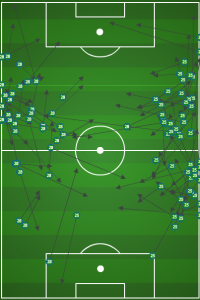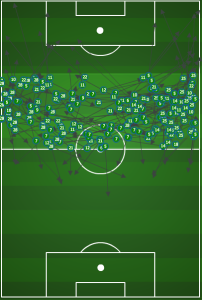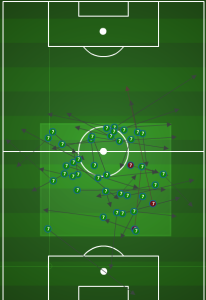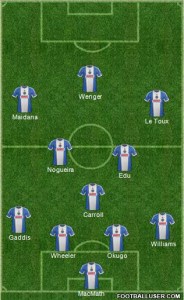Photo: Daniel Gajdamowicz
Who: Philadelphia Union at Montreal Impact
What: Regular season game
Where: Stade Saputo, Montreal, QC, Canada
When: 4:00 pm, Saturday, April 26
Watch: TCN, MLS Live, MLS Direct Kick
Referee: Baldomero Toledo; Linesmen: Eric Boria, Oscar Mitchell-Carvalho; Fourth official: Silviu Petrescu
The Philadelphia Union have not scored any open play goal in over two games. They just completed a home match without putting a shot on net. How does a team that dominates possession — and plays 12 minutes with an extra man — not register a shot on net? Where is the breakdown?
Nothing to hide
As good as the Union could be, they have glaring weaknesses. And thus far this season, they have let the opposition exploit those weaknesses with increasing regularity.
Houston has real difficulty defending wide areas. When New England played them two weeks ago, the Revolution got players deep on the wings, then brought in support to overload those areas and create lanes and gaps. It was a simple plan that the Union should have been able to replicate.
But Dom Kinnear watches his game tape. The Dynamo were willing to let the Union go just so far on the right before closing down space, respecting the skill of Sheanon Williams by nudging Ricardo Clark to his side and asking Jermaine Taylor and David Horst to play a fairly high line to compress space.
By overloading the right, Houston gave the Union the left. They closed down space heavily on the right and forced Amobi Okugo to play across to Aaron Wheeler (Okugo to Wheeler: 1 pass; Wheeler to Okugo: 5). The big man is still learning his defensive duties, so he is understandably still a long way from being a reliable passing option.
Falling into the trap
It is not a coincidence that Okugo and Sheanon Williams played over 60 first half passes between them while Wheeler and Gaddis played less than half that amount combined. Houston would let Okugo and Williams play together — and Nogueira would join — but if the ball advanced beyond 10 yards into the Houston half, the defense descended. If the Union wanted to play the ball across field to Wheeler and Gaddis though, by all means. The Dynamo wanted to force Wheeler or Carroll to start attacks, and their ability to force that outcome went a long way toward taking the teeth out of the Union offense.
Second, and relatedly, the Union were not able to get behind the Dynamo defense. And with the Houston playing fairly high up the pitch, that is an issue. It would be interesting to know exactly who the Union thought would stretch the defense last Saturday. Wenger? Maidana? Kinnear obviously thought nobody would, which allowed his defenders to compress the field and prevent Sheanon Williams from becoming a big factor high up the field on the right.
And last, but hardly least, Houston exploited the fact that Philadelphia has shown, and this strong language is warranted after last weekend, absolutely no idea how to translate possession into opportunities.
After Kofi Sarkodie was sent off, Brian Carroll went 19/19 passing. Mo Edu, Vincent Nogueira, Leo Fernandes, Sebastien Le Toux, combined for 17/21 during the same stretch. That is what no plan looks like when you are a man up.
The easy way out
But it is more than just other teams seeing through the Union that has doomed the local boys to mediocrity in 2014. Too often, Philly appears to mistake the option the other team gives them for the best option available. But remember: The other team is like Gollum. They may seem like they’re helping, but they are not really helping. Just because they give you space when you are wide does not mean you should cross the ball.
The other oddity of the Union’s play this year has been a willingness to give up the natural advantages their formation garners. Against New York, Leo Fernandes and Sebastien Le Toux pushed so high when Philly had the ball, that the team gave up its man advantage in midfield and made runners easy to track for the Red Bull back line.
Against Houston, Brian Carroll dropped deep to facilitate the offensive build up. This is in no way a bad thing. In fact, it can be incredibly good when it makes the ball move quicker around the back or draws the defense too high chasing the recessed midfielder. But when the deepest midfielder has a more limited passing range, a team needs to adjust by making short checking runs into the space in front of him to either force the defense higher or, if the defense doesn’t follow, get the offense started.
Curiously, the Union have not figured out how to generate offense with Brian Carroll dropping deep. Carroll’s passing chart from that role shows that he recycled play almost exclusively, with only three or so passes forward. Blaming Carroll for this is to ignore that the Union seem to accept this outcome as a positive, and have not sought to change their approach to how they develop attacks. Houston noticed this, and if Montreal’s Frank Klopas watches the tape closely, he will see the same things.
Enough doom and gloom
Yes, when you buy the expensive seeds, plant them in good soil, and water them regularly, it is confusing when they don’t grow. But this iteration of the Union remain a team that looks capable of controlling a game every time they step onto a pitch. That is a huge improvement from a year ago.
And in Williams, Okugo, and Gaddis, Philadelphia has one of the most talented young defensive trios in MLS. Whether Aaron Wheeler or Austin Berry joins in, the Union defense should look very good as the season goes on.
Changes
Sheanon Williams is already an excellent right back. Nobody in MLS will dispute that assertion. But his crossing has been woeful this season. Either his right foot lowers the force of gravity on everything it touches, or… well, I honestly cannot think of a better explanation for the moon shots coming off the right wing right now.
The crossing will improve, but as long as it’s bad, why not try a little experiment and switch the fullbacks. Ray Gaddis is much more confident going forward on the right, and teams have figured out that the Union are almost exclusively a one-sided team. If Sheanon Williams is even half as aggressive going forward on the left as he is on the right, it will force the opposition to be more honest in how they set up defensively.
Also, and unrelatedly, Conor Casey cannot start this weekend. The big man still has his uses, even if he does look far from fitness. But against a back line more vulnerable to speed than size, his huffing and puffing will be more useful off the bench.
So, finally, what to look for in Montreal
At minimum, the Union should look to play another error-free game. As numbing as the Houston game was, at least it produced no memorable individual errors. Put another way, it finally looked like Philadelphia was prepared for the opposition tactics.
The next step, of course, is to generate offense, and opportunities should abound this weekend. Montreal is playing their first match at Stade Saputo this year, and it would be no surprise to see a very attacking lineup on Saturday. Jack McInerney and Marco Di Vaio present a wholly different threat than Will Bruin and Giles Barnes. The Impact will be counting on the Union’s desire to score to open gaps in the midfield for Felipe, who stood out for how terrible he was the first time these teams met.
Hernan Bernardello is questionable with an ankle injury, leaving the continually fading Patrice Bernier and the inexplicably contracted Collen Warner as Montreal’s holding players. This is not a positionally sound duo, but they won’t just get out of your way. Philadelphia can draw Warner and Bernier out, but then they have to fill the middle with runners. Thus far, that second step has not occurred in 2014.
Second, Union wide players need to play like wide players, not like some weird soccer samurai that roam the countryside and pop up to make contributions at the eleventh hour. This team does not have a level of understanding to sustain that sort of system. Sebastien Le Toux, Cristian Maidana, and Leo Fernandes need to be somewhere, be there consistently, and make that somewhere a place where others are not. This means no running along the back four like a striker until the ball has moved up the field. It can wait.
Prediction: Union 2-1
Same as last week. Why change it when my record has been so good this year? This is another game that both teams will feel they simply must win. As in New York, it will get spread out and open and the team that can push the ball forward quickly but with purpose will be able to create early opportunities.






If the Union do not win in Montreal, the Union do not make the playoffs…
.
…and I may not be able to resist the temptation of the dark side.
That “possession dominance” graphic is downright depressing. It looks like a whole lotta nothing. Possession without direction.
.
Sorry Los, this wasn’t meant to be a response to you.
.
I agree with you 100%, by the way.
I could not agree more with your first statement. That sort of dominance should result in nothing but goals and wins. It’s absolutely disheartening.
Let’s hope for a sensible lineup and maybe we can pull something out.
Sigh.
At the very least, it should result in a shot on goal.
Possession dominance sure didn’t serve Bayern very well last night that’s for sure.
Jack is going to make Wheeler look like a toddler. Two of Hackworth’s decisions will interact in one big fiasco for the Union.
Jack who?
I have a pretty large project due at work tomorrow. I’ve been spending 10-12 hours days going back to last week to try and get it done, and today and tomorrow seem like they’ll be the same. So of course I just spent an hour or so looking over Adam’s predictions this year and trying to “quantify” his skill at pontificating. Because nothing says, “project crunch time!” like making up a method of data analysis on the fly for something completely unrelated to the project.
.
So first, a very, very big disclaimer. This is meant purely for fun and in no way – AT ALL – is a dig against Adam and his Carnac the Magnificent impersonation. (And I think I just dated myself with that reference.) I find Adam’s previews to be fantastic; I learn something from them every week. If predictions were easy, the Vegas sports books wouldn’t exist. OK, so on to the review…
.
I have three numbers I generated for each match – Prediction points, Union goal differential, and opponent goal differential. All could probably use refinement, but none more than the first.
.
Prediction Points: A higher score here is desired. If Adam predicted the correct result (regardless of number of goals scored), he got 2 points. For each “step” he was away from the correct result he received -1 point. So for example, if he predicted a win and they had a draw, he had minus 1; if he predicted a win and they lost, he had minus 2. Similarly, if he predicted a loss and they went out and won one for the Gipper, he would also get minus 2 points.
.
Union Goal Differential: A positive number here is good for the Union. It means they scored more goals than Adam predicted.
.
Opponent Goal Differential: From a Union perspective, a negative number here is the best scenario. That would mean they gave up fewer goals than Adam predicted.
.
Aside from those, I also calculated what the Union’s goal differential on the year would be if they hit Adam’s predictions every game, compared to their actual goal differential.
.
And a note: I didn’t see an actual prediction in the preview for the Pink Cows match, so there’s no “score” in my spreadsheet for that. All the data is based on the other seven matches.
.
So… overall, Adam has earned 2 “prediction points” from the 7 matches I have details for. Three times – Portland, NE, RSL – he correctly prognosticated the end result. His four misses were only by one “step” each, earning a negative point for each. Against the Crew he predicted a draw and they lost; the others were predicted wins that the Union managed to turn into draws. This looks pretty good, to be honest. A perfect hit 3 out of 7 is decent, and he hasn’t yet been so far off the mark as to get a -2 for any single game.
.
His Union Goal Differential score is -3. He predicted a total of 11 Union goals in those seven games, but they only actually scored 8. Adam was spot on for Portland (1 goal), Columbus (1 goal), and Chicago (2 goals). RSL was his biggest – and only – non-zero positive number, with a prediction of 0 and an actual of 2. NE and Houston both had a -2 score, while Montreal had a -1.
.
His Opponent Goal Differential is +4 – meaning the opponents have scored 4 goals more than Adam expected. His only correct prediction was Portland, with 1 goal against. The Union were better than expected, by one goal, against both NE and Houston. They were worse than expected by one goal against Columbus and Montreal. The real killers for his score here, though, are RSL and Chicago, both of whom scored 2 goals higher than predicted.
.
If Adam’s predictions were exactly correct for all seven matches, the Union would be sporting a +7 goal differential right now. Instead, they have the completely mediocre goal differential of 0 – they lost to Columbus by 1, they beat NE by 1, and tied everybody else.
.
What’s it mean? Probably not a damn thing. But I got this far, so I may as well keep making stuff up. I’d say Adam is good at getting the result; if he’s not spot on, he’s close. But for both Goals For and Goals Against, his overall predictions are too optimistic. Part of that is on the Union themselves; really, predicting 11 goals scored from 7 matches (1.57 a game) isn’t wildly unrealistic, but the Union just aren’t finding the net. Defensively, his predicted goals against of 4 in seven games (0.57 GAA) is a lot to ask for. The MLS single-season record, held by Kevin Hartman of FC Dallas in 2010, is 0.62. So Adam’s prediction, effectively, is for the Union to be on a record-setting pace. The team’s actual goals against of 8 in seven matches (1.14 GAA) isn’t great, either. So combine Adam’s optimism and the team’s (likely) underperformance here and you get the big swing of a +4 score.
.
And now, back to my project…
If I have time this weekend, I’ll go back and compare Union outcomes to an Expected Goals statistic based on shot locations and game states. I’m worried your analysis makes me look a lot better than I actually am at this!
Small sample size? 😉 (Yeah, yeah. I know. “That’s what she said.”)
.
It was mostly a distraction from my project, frankly. That said, I may continue my overly simplistic analysis through the season if having the results nit picked like this doesn’t bug you.
Not at all! In fact, I think it’s awesome. It’ll make me more determined to put some actual logic and numbers behind my choices.
I’m so glad John did this, I did a similar look. Adam’s on a rough ride this year but had a great stretch last season.
I used to love reading this feature to learn things, but now it’s just depressing. Well, I still love reading it, but the things I’m learning just make me very sad. All in 8 weeks time.
Has there ever been a time during the Hack era where any of us have turned the game on and said, “Sweet! That’s the lineup that I was hoping for?”
In light of that, I’m predicting that Fabinho, Wheeler, and Casey start, Maidana doesn’t…I’m half joking.
–
I feel like the solution to the switching of the wings is to start Maidana in the real #10 spot and drop Carroll (I know, I know). Just saying. Why not try HIM at the top of the triangle?
–
Prediction: 3-1 Montreal, w/ DiVaio getting 2 and Jack 1. Okugo gets ours off a corner. Depressing, but I don’t see Hack learning and I’m down…hoping I’m wrong cuz MTL is really bad.
Yeah, I actually agree pushing Maidana back into the midfield and letting him roam. How about this:
.
MacMath; Williams, Okugo, Berry/Wheeler, Gaddis; Edu; Nog, Maidana; Le Toux, Wenger, Fernandes.
.
Edu holds – he’ll still get forward plenty. Nog does the box-to-box thing, which lets him keep checking back, something he’s comfortable with, while still getting that sweet vision forward. Maidana creates. Anywhere he wants. If we let Maidana wander from a midfield spot, we don’t need to have his opposite winger cover his side. Le Toux can stay on the right where he’s most comfortable, and he and Williams can rebuild what they had last year. I’m not sure Fernandes is an every-game starter, but he was the best solution to come to mind pre-caffeine.
.
I like it! Somebody send Hackworth a memo.
John, great stuff! I hope you have more big projects in the future! As for Adam’s predictions on goals forced/against, did anyone really think they would be this bad inside the opposing 18? For all our predictions and such we all get a free pass. Also to improve the play this week hackworth had them practice square balls for 2 days straight!
Is that your preferred lineup as well as predicted lineup?
.
Its my preferred long term line up…yes even with Wheeler…wish we had a more speedy option for Le Toux…but for what we got, I think its best.